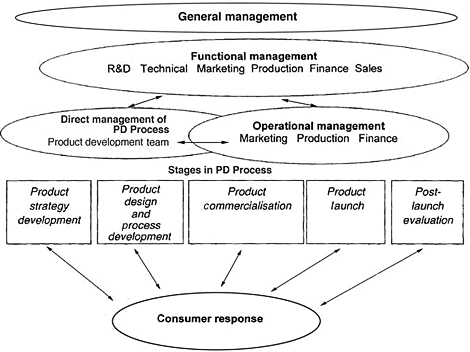FOOD
PRODUCT DEVELOPMENT
Mary Earle, Richard Earle and Allan Anderson |
| Loading
|
development |
|
||||
|
|
|
Part
I,
Chapter 1
Keys to new product success and failure 1.5.1 Company management and product development Top management leads product development by defining
the focus, setting up a system and organisation, ensuring resources and
making the critical decisions. It
needs to include the innovation strategy and the product strategy in the business
strategy, and also to identify any deficiencies in innovation culture,
knowledge, management and resources.
In company planning and in the building of the business strategy, the changes that drive innovation are predicted so as to give a long-term direction for the business strategy (Earle and Earle, 2000). It is important to study technological changes and social changes, including political and economic changes, and these give the basis for the innovation strategy. A checklist for analysis of the company and the industry, as shown in Table 1.5, is the basis for the changes to be made in the product mix and the associated services. Table 1.5 Product analysis in developing the product development programme
These two studies - innovation and products - lay the basis for the product development strategy within the business strategy. This analysis is balanced by the company's capabilities - the market position, the supply position, the product, production and marketing knowledge and skills, the plant, marketing and financial resources. Then the product development strategy and the plan for the future can be developed. Planning in this way ensures that the strategic management of product development is connected with the company's overall business strategy. The product development strategy is then an amalgam of the company's innovation, product and technology strategies and gives direction to the whole product development programme. From the strategy is developed a product development programme and top management sets the budget and the other resources for this programme. The question is how to set this budget. For example on past sales and profits, on the predicted sales and profits if the product development is successful or on the predicted costs? This is an important decision as too tight a budget restricts the project and also the breadth of changes in the final product; too expansive a budget can lead to a wandering programme and too much research for research sake and not for development of the product. The top management has to be ultimately responsible for setting up an organisation for the product development programme, a diverse activity involving general management, production, marketing and finance, with the product and process development team. Today product development is recognised as an integrated multifunctional process, which combines and coordinates the work in all departments and groups as shown in Fig. 1.8.  Fig. 1.8 Management for product development. The organisation has to be structured to give an efficient process with an effective outcome. Companies often place the incremental improvement projects in functional areas or in a strategic business unit, and the major innovation projects in joint committees or separate venture groups (Griffin, 1997). The top management introduces integrated procedures, aims, attitudes and methods into product development. It also indicates the decisions that it will take at specified times and the knowledge it needs for these decisions. |
|
 |